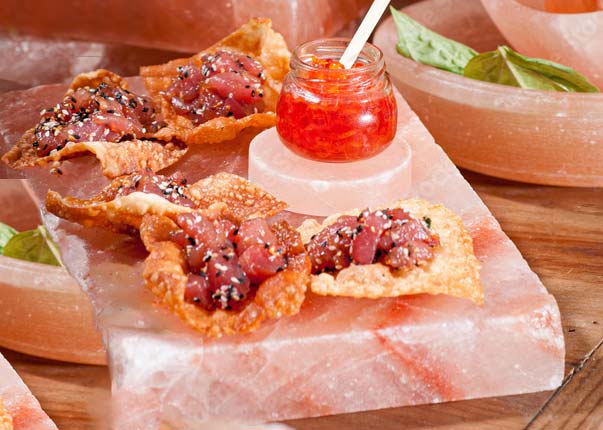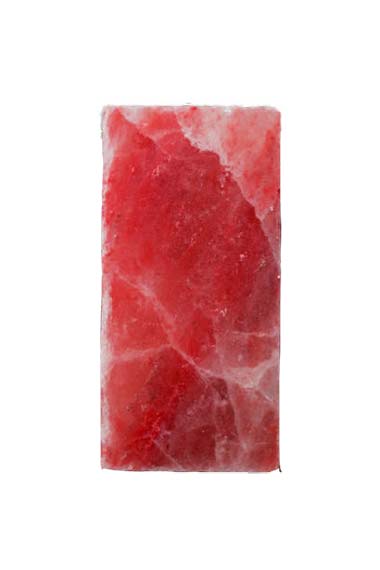At the exclusive culinary event, savory delights were expertly crafted on Himalayan salt blocks, imparting a unique and exquisite flavor profile to each dish. In the world of gastronomy, innovation knows no bounds, and chefs are constantly seeking unique ways to tantalize taste buds. One such trend that has emerged in recent years is the use of salt blocks as a cooking surface. These blocks not only add a touch of theatricality to the culinary experience but also impart a distinct flavor to dishes prepared on them. In this article, we will explore the art of creating chilling dishes on salt blocks and the delightful results that ensue.
The Salt Block Experience:
Salt blocks, typically made from Himalayan pink salt, are not only visually appealing but also boast the ability to conduct and retain heat evenly. This makes them an ideal cooking surface for a variety of dishes, particularly those that benefit from a touch of salinity. From seafood to thinly sliced meats and even vegetables, the possibilities are vast when it comes to crafting cold-inspired creations.
Chilled Seafood Extravaganza:
Imagine a spread of freshly shucked oysters, delicate ceviche, and succulent shrimp arranged on a bed of a frozen salt block. The salt block imparts a subtle seasoning to the raw seafood, enhancing its natural flavors. As the dish rests on the chilled surface, it provides a refreshing contrast that elevates the dining experience.
Frozen Delights and Sweet Surprises: It’s not just savory dishes that shine on salt blocks; dessert enthusiasts have found innovative ways to incorporate these blocks into sweet treats. Artisanal ice creams, sorbets, and frozen fruits take center stage as they are skillfully presented on the frozen salt block. The slow melting process enhances the sweetness and texture of the desserts, creating a symphony of flavors that dance on the palate.
Sliced Thin, Served Cold:
For those who appreciate the elegance of thinly sliced meats, the salt block serves as an exquisite canvas. Delicate carpaccios and sashimi-grade fish are expertly sliced and arranged on the chilled surface. The contact with the salt block imparts a nuanced seasoning to the raw slices, creating a fusion of temperatures and tastes that captivate the senses.
Tips for Cooking on Salt Blocks:
1. Preheat Gradually:
To avoid cracking the salt block, it’s essential to preheat it gradually. Start with low heat and gradually increase to the desired temperature.
2. Experiment with Ingredients:
The versatility of salt blocks allows for experimentation with various ingredients. Play with contrasting flavors and textures to create a memorable dining experience.
3. Regular Maintenance:
Proper care of the salt block is crucial for longevity. After use, allow it to cool before cleaning it with a soft brush or cloth. Avoid using soap, as the salt block will naturally inhibit bacterial growth.
Cooking on salt blocks has evolved from a culinary trend to a bona fide art form. The marriage of chilled dishes and the natural seasoning provided by the salt block creates a sensory experience that is both visually stunning and palate-pleasing. Whether it’s a seafood soirée or a frozen dessert extravaganza, the salt block has proven its place in the world of avant-garde cuisine, inviting chefs and home cooks alike to explore the boundaries of flavor and presentation.
Chilled Dishes on Salt Blocks across the Globe
In the dynamic world of gastronomy, culinary trends often transcend borders, and one such phenomenon gaining international acclaim is the use of salt blocks for creating chilled dishes. From Asia to Europe and the Americas, chefs worldwide are embracing the unique qualities of salt blocks to enhance the flavors and presentation of their dishes. In this article, we’ll take a global journey to explore how various countries incorporate chilled dishes made on salt blocks into their culinary repertoire.
1. Japan:
Sashimi on Salt Blocks Renowned for its precision and dedication to culinary art, Japan has seamlessly integrated salt blocks into its traditional cuisine. Sashimi, thinly sliced raw fish, is often delicately arranged on frozen salt blocks. The blocks not only impart a mild salinity but also contribute to the overall aesthetic appeal of this Japanese culinary art form.
2. Peru:
Ceviche Elegance In the vibrant culinary scene of Peru, where ceviche reigns supreme, chefs are elevating this classic dish by presenting it on salt blocks. The chilled surface enhances the freshness of the raw fish and the tangy citrus marinade, creating a delightful harmony of temperature and taste.
3. United States:
Seafood and Beyond Across the United States, particularly in coastal regions, the use of salt blocks for preparing chilled seafood has become a trend. From New England lobster to Gulf Coast shrimp, chefs are placing these oceanic delights on frozen salt blocks, allowing diners to savor the natural flavors heightened by the touch of salt.
4. Italy:
Carpaccio and More In Italy, where culinary traditions are deeply ingrained, chefs have embraced the salt block trend by featuring thinly sliced meats like carpaccio. The salt block imparts a subtle seasoning to the delicate slices, creating a sensory experience that resonates with the sophistication of Italian cuisine.
5. India:
Cooling Spices on a Salt Canvas Known for its diverse and flavorful cuisine, India has also joined the global trend of using salt blocks. Chilled desserts infused with aromatic spices, such as cardamom and saffron, are presented on these blocks, offering a unique fusion of traditional flavors with a modern twist.

As the culinary world becomes increasingly interconnected, the use of salt blocks for creating chilled dishes has become a global phenomenon. From the precision of Japanese sashimi to the vibrancy of Peruvian ceviche and the diverse applications in the United States, Italy, and India, chefs worldwide are finding innovative ways to incorporate salt blocks into their culinary creations. This trend not only adds a touch of spectacle to the dining experience but also showcases the universal appeal of exploring new dimensions in taste and presentation.
Looking for salt blocks: Click here





